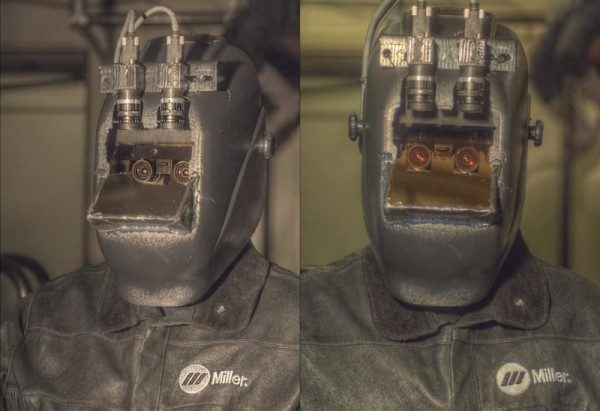What you see above is not an alien visitor but rather a normal human wearing a prototype augmented reality welding mask. This system, dubbed ‘MannVis welding helmet’ by its creators, allows welders to see their work with an incredible level of detail that far surpasses what the human eye is capable of. It’s great to finally see a practical application of augmented reality when there are so many useless and novel augmented reality demos out there. The augmented reality welding system is not only useful for helping experienced welders to do better work, it is also quite useful for teaching welding techniques to students of the skill.
The welding process creates a light so bright that welders must wear masks that block the vast majority of visible light. Blocking most visible light means that the light is dimmed enough that the welder can get a good idea of where his welding implement is. Even with massive amounts of dimming, the tip of the welding torch can still be too bright to see exactly where the weld needs to be done and also makes it impossible to see much surrounding the welding area which can complicate matters. The amount of light varies depending upon the type of welding, but in general if you don’t wear a mast you can permanently damage your eyes very quickly.
Old School Style
Old school welding masks have a flip down panel. Prior to lighting the welding torch, the panel is flipped down so that the welder can get a decent idea of where the tip of the implement is. To check their work, the welder has to stop the torch and flip up the panel to take a look. Repeating this process can be rather time consuming.
Modern welding masks have sensors which automatically dim a panel in front of the user’s eyes. The panel automatically dims when the user begins welding. The panel automatically goes back to a normal level of transparency when the welder turns off the torch. This fixes the time consuming flipping up and down of the panel on older helmets but it is still hard to see the tip of the welding torch because of the low contrast ratio of the human eye.
Contrast Ratio and High Dynamic Range Imaging
Contrast refers to the difference between the darkest shade that can be seen and the lightest shade that can be seen. Human eyes have a relatively low contrast ratio meaning that we don’t do well when it comes to seeing scenes which have both very dark objects. Our eyes can dilate to shift our contrast ratio range up or down, but we cannot enhance the natural contrast ratio.
Multiple exposures of photos can be combined through a technique called High Dynamic Range imaging (HDR). This technique takes multiple exposures of a single scene and combines them together to form a photo which has properly exposed features across all levels of brightness.

Real-time HDR Videos Make the Augmented Reality Welding Mask a Reality
Thanks to the ever increasing power of computers it is now possible to render not just HDR images but HDR videos as well.
The creators of the MannVis augmented reality welding helmet have come up with a set of complex algorithms which allow real-time processing of HDR videos at 120 frames per second — in stereoscopic 3D, no less. The process creates an effective contrast ratio of 100,000,000:1 which is far beyond natural human capability. This incredible contrast ratio is used in an augmented reality view to show the welder inhuman detail as they weld.
In simple terms, the augmented reality welding mask diverts the incoming light into two cameras (two cameras are necessary for stereoscopic 3D which is very important for welding). Images are captured at 120 frames per second and processed into HDR composites in real time. Each HDR image requires 4 standard images of varying exposures to create the final HDR frame; the resulting output (which is sent to the eyes of the welder) is 30 frames per second.
The research team behind the project consists of Steve Mann, Raymond Lo, Jason Huang, Valmiki Rampersad, Ryan Janzen, and Tao Ai. The official site for the project can be found here. The team published a paper detailing their HDR algorithms in the SIGGRAPH publication and presented the augmented reality welding helmet at the SIGGRAPH 2012 conference in Los Angeles.
As computers become even more powerful, it will be possible to do similar real-time HDR image processing with little more than a smartphone. There will be a point down the road where humans will be able to manufacture cheap and lightweight glasses that are capable of providing better imaging than our own eyes can manage. This will be one of several points where true augmentation of human capabilities begins — the very definition of cyborg. It’s not science-fiction, it’s the future.







